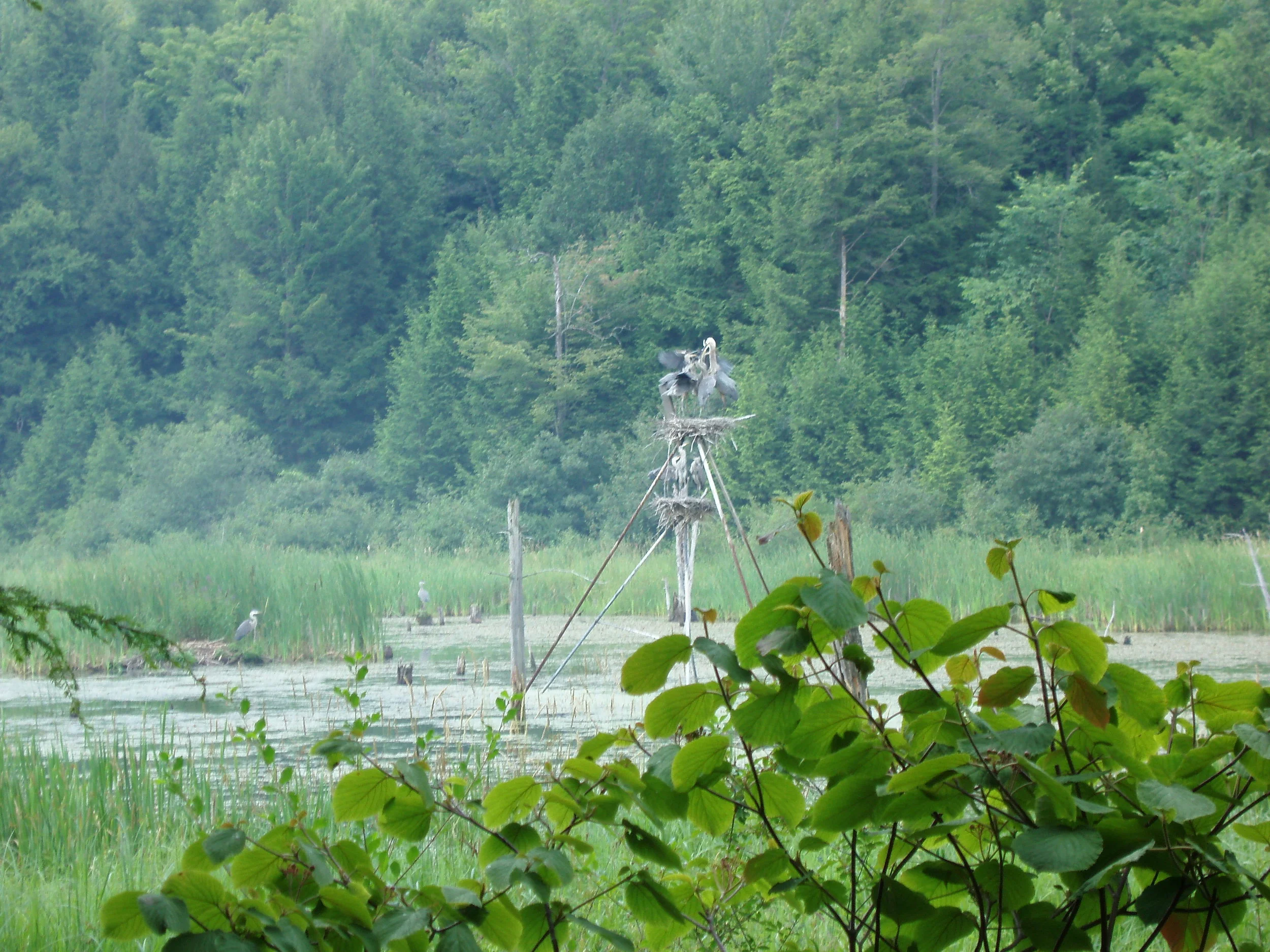Background
Ascutney Mountain Audubon Society (AMAS) first became aware of a small Great Blue Heron rookery located in a beaver pond in Weathersfield, Vermont, around 1985. At that time, there were four active nests. In 1990 nine nests were counted, increasing to a high of twelve in 1992. During the monitoring of this rookery over the years, AMAS learned that these herons are easily disturbed and will flush off the nest when approached within 200-300 feet, even when the monitoring personnel were screened behind the surrounding hemlock trees. Protection for this rookery, located on private land, seemed to be warranted.
In 1990, taking advantage of the relatively new Vermont Wetland Rules, AMAS petitioned the Vermont Water Resources Board to establish a larger buffer zone around the rookery. Vermont Wetland Rules automatically establish a buffer zone of 50 ft around any wetland, prohibiting development (including road construction) within that zone. AMAS, with the cooperation of the landowner, petitioned for a 300 ft. buffer zone around the section of the beaver pond where the nest sites exist. AMAS presented this petition at several public hearings and produced a survey map showing the edge of the wetland and the boundaries of the proposed buffer zone. In March 1992, the Water Resources Board granted AMAS' petition and established a 300 ft. buffer zone around the rookery portion of the beaver pond.
Action Needed
Following the high count of twelve nests (which fledged 38 young) in 1992, members of AMAS found that the nesting trees were beginning to fall over from rot (these are dead pines in standing water). In 1993, there were only six active nests remaining. It appeared that in order to keep the herons from abandoning the site, an artificial nesting site project was needed. Upon searching the scientific literature, AMAS found that very little had been done in providing such sites for herons, although much had been done for osprey. Researchers in Oregon and British Columbia provided information on work that they had done, and with this information, AMAS approached the Vermont Department of Fish and Wildlife for additional assistance. In the winter of 1993, again with the cooperation of the landowner as well as some funding by the Fish & Wildlife Department's Non-game Fund, three artificial nest sites were set out. One was a single pole with a platform, set into the ground at the edge of the wetland. The other two were tubular steel tripods with basket-like arrangements. These were located in the beaver pond during winter by working through the ice and embedding the ends of the tripods into the mud of the pond bottom. One of these tripods had two nesting "baskets."
In the spring of 1994, more trees had fallen, but a pair of herons accepted one of the artificial sites (the lower basket of the two-basket tripod). As soon as this was discovered in April, AMAS did not again approach the colony again until June 28, when the young were fully feathered and perched either at the edge of the nests or in the branches of adjacent trees. Five active nests were counted, and a total of 18 young, with three young perched on the edge of the nest in the tripod basket.
Obviously, AMAS' artificial nesting site project was a success, although somewhat limited. Research of additional literature on the subject indicates that a large number of artificial nest sites are preferable so that the herons have a wide choice. During the winter of 1994-5, an additional tripod was installed in the pond. In March of 1996, two more metal tripods were set out, through the courtesy of the landowner, and in March of 2003, an additional tripod was erected with the help of one of the landowners. This brings the number of nest sites available to the herons to 12, 11 on the six tripods and one on the pole.
Sam Gurney and Willis Wood assembling a tripod.
Nesting Data
The following is a chronology of the Weathersfield Heron Project. Special thanks go out to Eleanor Ellis who was instrumental in the development of the rookery, Sam Gurney who built the tripods used by the herons, and to Willis and Tina Wood for their help over the years.
Summer 1985 - Four active nests discovered, all in trees
Summer 1990 - Nine active nests, all in trees
Spring 1992 - Twelve active nests, all in trees, 38 young (Record year)
Summer 1993 - Six active nests, all in trees
Winter 1993-4 - AMAS installs first two nesting tripods and nesting pole
Summer 1994 - Five active nests, four in trees and one on a tripod, 15 young in tree nests and three young on tripod nest
Winter 1994-5 - Nesting tripod installed
Summer 1995 - No data available
Spring 1996 - Two tripods installed
Summer 1996 - Three active nests, all on tripods, nine young
Summer 1997 - Three active nests, all on tripods, nine young
Summer 1998 - Four active nests, all on tripods, 11 young
Summer 1999 - Five active nests, all on tripods, 13 young
Summer 2000 - No census taken
Summer 2001 - Five active nests, all on tripods, 15 young
Summer 2002 - Six active nests, all on tripods, 13 young
Spring 2003 - One tripod installed
Summer 2003 - Seven active nests, all on tripods, 23 young
Summer 2004 - Six nests, 16 young
Summer 2005 - Six active nests, and 8 young (late census)
Summer 2006 - Eight active nests on six tripods, 17 young
Summer 2007 - Six active nests, 13 young
Summer 2008 - Six active nests, 21 young
Summer 2009 - Five nests on four tripods, 18 young on 20 June 2009
Summer 2010 - Seven young on 5 July 2010
Counting the chicks.






